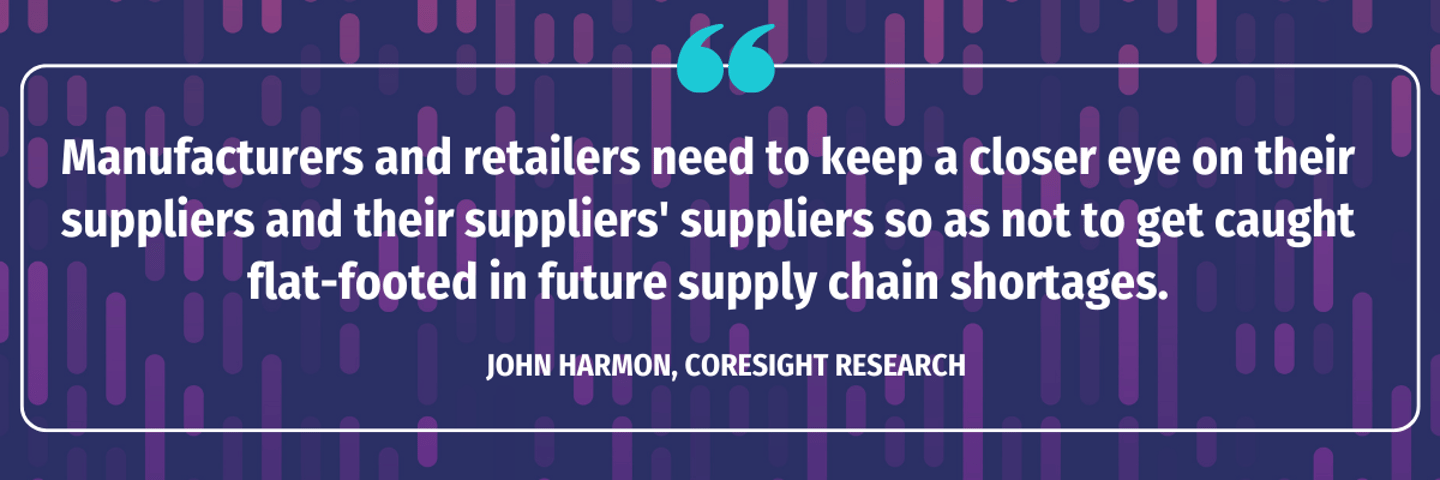What are the Trends Shaping the Global Supply Chain in 2023?
Today’s supply chain technology trends are being influenced by a host of factors around the world, many of which are having dramatic impacts on CPG companies and their ability to serve consumers.
What are the trends impacting global supply chains?
The primary trend today is a shift in challenges from the supply side to the demand side, according to Adheer Bahulkar, managing director and global supply chain leader for consumer goods at Accenture. Although commodity markets have improved, easing raw materials and global transportation issues, this is not due to increased supply, he says. Instead, companies have built resilience by identifying alternative sources and creating alternate manufacturing solutions.
Beyond this, there are a number of other other, important current trends in supply chain management that are important for consumer goods executives across all functions to keep their eyes on. Among them:
Digital transformation: For CPG companies, digital transformation is a key trend impacting supply chains. “Many companies are undergoing comprehensive digital transformations, integrating technology across their supply chain operations, including a well-engineered supply chain dashboard, supply chain control towers and a supply chain command center,” says Sourav Banerjee, Infosys SVP and industry head, consumer retail and logistics.
Real-time visibility: Demand for real-time visibility is being called for across the entire supply chain, and gaining a comprehensive, holistic view requires integrating data from disparate sources — including from both internal sources and third parties.
Artificial intelligence: Leveraging advanced analytics, including machine learning and AI, to predict demand patterns, identify potential disruptions and optimize inventory management is another area of focus for CPG industry supply chains, according to Banerjee.
What are the supply chain priorities in 2023?
Supply chain issues today are quite different from the ones that occurred during the pandemic, notes Mike Graziano, consumer products senior analyst with RSM US, with companies now more focused on inventory and manufacturing visibility and supplier lead times.
“The biggest challenge today is being better able to predict demand so that inventory levels can be better managed and mitigate the risk of excess inventory,” he notes, “which will result in margin compression over the longer term as discounting strategies are implemented to sell through older products.”
What are the big challenges for supply chains in 2023?
Almost half (44%) of all supply chain executives expect to experience a supply chain shock in the next 24 months as a result of various external challenges, according to Deloitte.
Today’s most pressing obstacles include the continued slow freight market recovery, according to Dustin Verdin, Zipline's executive director of business innovation. Global transit delays of goods and materials are also serving as obstacles, as well as shortages of qualified labor, geopolitical events, weather events, and national legislative decisions.
What are the future trends in supply chain?
We tapped a number of experts for predictions into the future of top consumer goods companies'supply chain and future challenges in supply chain management.
While the pandemic is in our rearview mirror, it left a higher degree of volatility in its wake, says John Harmon, senior analyst at Coresight Research.
“The U.S.-China tech rivalry is likely to also add volatility to supply chains, as a great deal of electronics manufacturing and assembly is performed there,” he added. “Manufacturers and retailers need to keep a closer eye on their suppliers and their suppliers' suppliers so as not to get caught flat footed in future supply chain shortages. The subsidies in the US CHIPS act and Intel's move into the foundry space could ensure that more chips are available domestically.”
Beyond this, supply chain convergence will accelerate rapidly in the next few years, says Infosys’ Banerjee, which he defines as identifying and reconstructing broken functional silos to instead yield end-to-end business processes optimizing traditional domains under an “ecosystem-first” perspective.
“This calls for thinking differently, using what we call an ‘outside-in’ approach to aligning all an enterprise’s functional supply chain silos,” he says. “Success here will ensure your company can provide that flawless customer experience everybody wants, and empower your organizations to maximize revenue capture and expand profit margins.”



